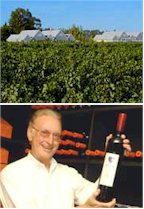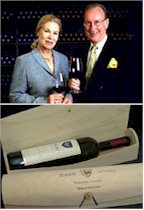 |
 |
|
| Metala was the first ever to win Jimmy Watson Trophy, a significant accolade in the world of wine. Fruit for the White Label is sourced from splendid Langhorne Creek vines which can trace a heritage back to the original plantings of 1891. Metala» |
|
| Villa Maria possess the magic touch with Pinot Gris, regularly clearing international wine events of prestigious trophies. Private Bin has been included in the Decanter Top 50 Best Under £10 and identified as a Decanter favourite. Villa Maria» |
|
| The enthusiastic maritime climes of Martinborough are heaven sent for a style and quality of Sauvignon Blanc to rival the world's finest. Mother nature sets the stage, but ultimately it is the thoughtful viticultural practices of the Palliser Estate team, which ensures a harvest of ripe and intensely flavoured Sauvignon Blanc at every vintage. Palliser Estate» |
|
| The High Trellis paddock has been yielding the most splendid vintages of wine since the late 19th century, so nicknamed as the vines were the first to be trained above knee height following acquisition of the property by dArenberg. For decades, High Trellis Cabernet Sauvignon has been released to unanimous critical acclaim by the wine industry press and international cognoscente. dArenberg» |
|
| Blackjack has claimed the eminent M.Chapoutier Trophy for Best Shiraz at the prestigious Le Concours des Vinson on no fewer than three occasions. Block 6 is a superior parcel of distinguished vines, renowned within the Bendigo district for producing a very high quality, intensely fruit driven Shiraz. Blackjack» |
|
| By the winner of the 2014 Jimmy Watson Trophy! During his time as chief red wine maker at Hardy's, Stephen Pannell became intmate with many of the greater Adelaide region's most splendid sites. A predominantly Syrah wine with a de rigueur inclusion of good Viognier, all picked off a superior low yielding Adelaide Hills vineyard. SC Pannell» |
|
| The Daisy Hill district thrived throughout the 1850s, due to its location along the main route to and from gold fields. The Amherst property sits atop old alluvial tailings, ancient diggings can still be seen around the property dressed in rich quartz soils. Amherst» |
|
| Originally planted during early settlement, the sandy loam soils of Haan Vineyard yield an outstanding quality of Shiraz. Fortuitously positioned along the hallowed mile of Siegersdorf Road, mid way between the ancient winegrowing hamlets of Angaston and Tanunda, the heirloom parcels once known as Hanenhof, have claimed significant trophies at the prestigious London International. Haan» |
|
| Bloodstone was originally intended for the UK Oddbins retail chain. It turned into a runaway success and went on to claim a litany of international accolades, 5 Cuisine Magazine Stars & Best Buy, as well as Gold & Double Gold at the prestigious San Francisco International. Gemtree» |
|
| Whole bunches and oak barrel ferments, the costly extravagance of three years tirage on sedimentery yeast lees, each bottle individually riddled by hand, disgorged and sent to cellar for the ultimate indulgence of extra age before release, Pamela is the zenith of the sparkling winemaker's art. Her luxurious effervescence exudes brioche, tarte tatin and French boulangere, her creamy textural mousse unravelling ribbons of rich yeasty autolysis, crème caramel and baked fruits. Wicks» |
|
| Saint Clair continue to deliver Marlborough's most internationally lauded Sauvignon Blanc. The winemaking team are on a perpetual odyssey, to isolate and retain Marlborough's finest harvests, capable of producing wines with intense regionality. Saint Clair» |
|
| Named for a rare grasshopper Sigaus childi, found only at Central Otago within the Earnscleugh gold mine tailings, just across the road from Grasshopper Rock vineyard. The site is fortuitously harsh and sufficiently challenging to make the vines work their hardest. Grasshopper Rock» |
|
 |
|
|
| |
|
| |
|
| |
|
| |
|
| |
|
About Haan - the Winery
Haan
They travelled the world in search of the ultimate home, a place that would fulfil their dream of making very special wine, they kept returning to the Barossa Valley, drawn by all it had to offer
After 26 years in the Hong Kong airline industry, Baron Hans Rudolf Haan established Haan Estate Wines in 1993, acquiring 26.3 hectares near Tanunda. The original site Hanenhof was initially planted in 1853 by George Friedrich Schmidt, who purchased the property for a pound an acre. The celebrated Barossa Merlot virtuoso James Irvine, assisted in the establishment of Haan by restoring and replanting the ancient vines. He further left his legacy on Haan Estate by mentoring the winemakers. The 18-hectares surrounding Hanenhof Estate consist mainly of the sandy loam soils which dominate Barossa Valley floor. These soils have proven excellent for producing rich, luscious Shiraz and Cabernets, varieties that have made the Barossa famous throughout the world. Hans and Fransien Haan renovated an 1850s vintage farmhouse, with a cottage, studio and tennis court, to make a homestead winery with a beautiful garden.

Barossa remains a unique district that maintains many of the great traditions lost in other areas. The local Barossa inhabitants work towards a strong commitment to preserving a great vineyard heritage. Barossa is blessed with a climate that exhibits four very distinct seasons, and a wonderful sense of community where everyone works together for the common good, taking pride in the achievements of one and all. The Haan philosophy meant that Hanenhof Vineyards would be holistically managed as a true wine estate. Providing the best possible conditions in the vineyard has been the key to success, along with a clear understanding of how to achieve excellence in the winemaking.
Plantings include shiraz and cabernet sauvignon, merlot and viognier, cabernet franc, malbec and petit verdot. All of the production receives excellent attention to detail from the dedicated Haan vineyard team.
Grapes are picked at optimum maturity for each wine type, treated to a gentle fermentation and transferred into French oak barriques to mature. The barriques are housed in the beautifully designed maturation cellars that dominate the entrance to the Estate's buildings.

All vines in the Haan vineyard are cane pruned with 30 buds to the vine and vertical shoot positioning to give a ballerina effect. Water management is essential and the key to a good harvest. The grapes are harvested at their optimum ripeness and processed with as little intervention as possible. Grapes are destemmed and fermented in small batches. Elevage is in a mixture of new and older barriques and hogheads for both the Classic and Prestige range. The use of both American oak, which offers a sweeter spice profile, and French oak - which shows more savoury spices and delicate tannin profile, helps to create wines of power and elegance.
Depending on the variety, the wines may remain in oak for up to 24 months, followed by further bottle maturation prior to release, with the eventual aim that the red wines will be available at around 2.5 years of age. Most of the vines are on a simple vertical trellis system with moving wires to lift the foliage and expose the fruit to the sun for full development of flavour and character. The Haan philosophy of providing the best possible conditions in the vineyard in order to encourage the most outstanding result in the bottle has certainly been rewarded with outstanding wines. Haan ultimately triumphed with the highly coveted Australian Wine Producer of Year, followed by Trophy and Medals for outstanding successes at the London International Wine & Spirit Competition.

|
|